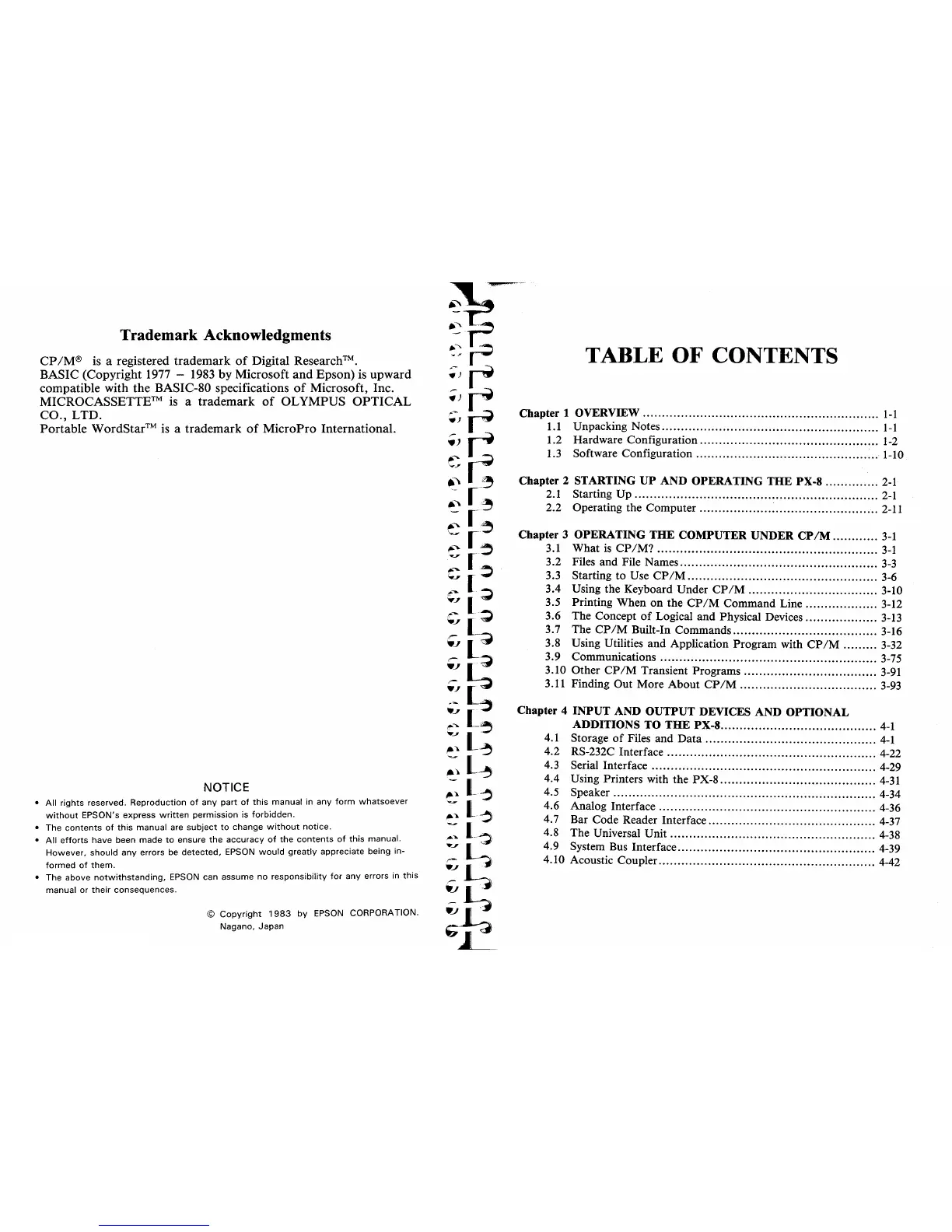Trademark Acknowledgments
CP/M® is a registered trademark
of
Digital Research™.
BASIC (Copyright 1977 -
1983
by Microsoft
and
Epson) is upward
compatible with the BASIC-80 specifications
of
Microsoft, Inc.
MICROCASSETTE™
is
a trademark
of
OLYMPUS
OPTICAL
CO., LTD.
Portable WordStar™
is
a trademark
of
MicroPro International.
NOTICE
•
All
rights
reserved.
Reproduction
of
any
part
of
this
manual
in
any
form
whatsoever
without
EPSON's
express
written
permission
is
forbidden.
•
The
contents
of
this
manual
are
subject
to
change
without
notice.
•
All
efforts
have
been
made
to
ensure
the
accuracy
of
the
contents
of
this
manual.
However,
should
any
errors
be
detected,
EPSON
would
greatly
appreciate
being
in-
formed
of
them.
•
The
above
notwithstanding,
EPSON
can
assume
no
responsibility
for
any
errors
in
this
manual
or
their
consequences.
©
Copyright
1983
by
EPSON CORPORATION.
Nagano,
Japan
TABLE
OF
CONTENTS
Chapter 1 OVERVIEW
..............................................................
1-1
1.1
Unpacking Notes
.........................................................
1-1
1.2 Hardware Configuration
...............................................
1-2
1.3 Software Configuration
................................................
1-10
Chapter 2 STARTING
UP
AND OPERATING
THE
PX-S
..............
2-1
2.1
Starting Up
................................................................
2-1
2.2 Operating the Computer
...............................................
2-11
Chapter 3 OPERATING
THE
COMPUTER UNDER
CP/M
............
3-1
3.1
What
is
CP/M?
..........................................................
3-1
3.2 Files and File Names
....................................................
3-3
3.3 Starting to Use
CP/M
..................................................
3-6
3.4 Using the Keyboard Under
CP/M
..................................
3-10
3.5 Printing When on the
CP/M
Command Line
...................
3-12
3.6 The Concept
of
Logical and Physical Devices
...................
3-13
3.7 The
CP/M
Built-In Commands
......................................
3-16
3.8 Using Utilities and Application Program with
CP/M
.........
3-32
3.9 Communications
.........................................................
3-75
3.10 Other
CP/M
Transient Programs
...................................
3-91
3.11 Finding Out More
About
CP/M
....................................
3-93
Chapter 4
INPUT
AND
OUTPUT
DEVICES AND OPTIONAL
ADDITIONS
TO
THE
PX-S
.........................................
4-1
4.1 Storage
of
Files and Data
.............................................
4-1
4.2 RS-232C Interface
.......................................................
4-22
4.3 Serial Interface
...........................................................
4-29
4.4 Using Printers with the PX-8
.........................................
4-31
4.5 Speaker
.....................................................................
4-34
4.6 Analog Interface
.........................................................
4-36
4.7 Bar Code Reader Interface
............................................
4-37
4.8 The Universal Unit
......................................................
4-38
4.9 System Bus Interface
....................................................
4-39
4.10 Acoustic Coupler
.........................................................
4-42
